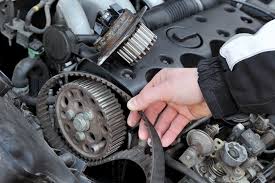OK, spring is here. Along with spring break, the hot together starts to arrive. One of the things that we think about at this time is our automobile.
things that we think about at this time is our automobile.
While driving the kids around for school activities might or might not be enjoyable in some ways, one thing’s for sure: this driving places certain special strains and demands on your vehicle, due to the added miles driven and perhaps additional time waiting in a school pick-up and drop-off line with your engine idling. This means it’s important to make sure that your car is ready to handle these driving conditions. There are a number of areas of the car that should be checked or serviced leading up to the beginning of the hot season.
Air Conditioning
In the Tampa Bay area, the hot season starts now. So, let’s start with a little thing that makes it bearable to drive the kids in the sweltering heat; the air-conditioning system. Your AC keeps you cool and happy in 90 plus degree temperatures, and it usually works hard during the hot months. It’s important to give your air conditioning system a clean bill of health heading into back-to-school time.
You’ve probably been running your air conditioner during the winter, but it’s a good idea to ensure it’s working normally. A bad smell, squeaking or other noises, or anything else out of the ordinary may indicate you have an issue our Automotive Experts might need to address.
You’ll want to make sure that the AC belt is in tip-top shape. Signs that the AC belt is in need of replacement can include cracks in the belt surface or squeaking noises while the air conditioning is running. If your AC belt is in bad shape at the start of summer, there’s a chance it will give way at a bad time, and it’s probably best to change it now before it’s inconvenient to take the car in.
Another part of the AC system you’ll want to have checked at the beginning of the school year is the refrigerant level. Note that air conditioning refrigerant is a toxic substance, and it may be best to let our trained and certified professionals check your levels and system pressures.
Engine Cooling System
Just like you need to keep cool during the hot months, the same is true of your engine. Your vehicle features an extensive and complex cooling system to keep your engine running at acceptable temperatures, and that cooling system faces its greatest challenge during hotter weather.
The engine’s cooling system tries to keep the engine at around 200 degrees on most model cars, which confers a number of performance benefits. These range from optimal fuel combustion to correct oil viscosity to protection against corrosion and wear and tear.
In the July and August heat, the cooling system is taxed, and if it’s not in good shape the coolant can rise to temperatures which can cause the engine to overheat. Engine overheating can result in irreversible damage, and it’s much better to make sure your cooling system is functioning well now, in a preventative sense, than deal with permanent – and costly – consequences.
First, you should have your coolant checked, which includes both the coolant level and also the chemical concentration of the coolant. We’ll also want to make sure that your radiator and hoses are in good shape, as any cracking or leaking can indicate a cooling system not functioning at peak level. It’s also important to verify that the drive belts and clamps are tight and in good condition.
When driving in warmer weather, it’s always a good idea to be mindful of your engine’s heat levels. The temperature gauge will let you know if your car is overheating. If your temperature gauge or warning light indicates overheating, it’s absolutely imperative to pull over and shut the engine off immediately, of course, remaining cognizant of surrounding traffic and safety. One immediate trick you can do if traffic keeps you from immediately shutting off the engine while it’s overheating is to flip on the heater. This may seem weird during hot weather, but your car cabin’s heating system works by transferring heat from the car’s engine to the interior, so this transfer of heat may help cool an overheating engine a tiny bit.
Lim’s Auto Body is a full service auto body and mechanical repair shop locally owned and operated in Largo, Florida. For more information, go to our web site www.limsautobody.com or call (727) 422-3232.

 are subject to a lot of wear and tear. You may not be ware that you can provide preventative maintenance.
are subject to a lot of wear and tear. You may not be ware that you can provide preventative maintenance.